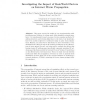Free Online Productivity Tools
i2Speak
i2Symbol
i2OCR
iTex2Img
iWeb2Print
iWeb2Shot
i2Type
iPdf2Split
iPdf2Merge
i2Bopomofo
i2Arabic
i2Style
i2Image
i2PDF
iLatex2Rtf
Sci2ools
ICISS
2007
Springer
2007
Springer
Investigating the Impact of Real-World Factors on Internet Worm Propagation
This paper reports the results of our experimentation with modeling worm behavior on a large scale, fully adaptable network simulator. Our experiments focused on areas of worm scanning methods, IP address structure, and wireless links that, to the best of our knowledge, have been mostly neglected or abstracted away in prior worm simulations. Namely, our intent was to first study by direct observation of our simulations the effects of various IP scanning techniques on the effectiveness of worm spread. Second, our intent was to research the effects that having a larger IP address space (specifically a sparsely populated IP address space like that provided by Internet Protocol Version 6) would have on the effectiveness of several worms. Third, we study how the wireless media may affect the propagation of worms. In order to perform these simulations we have made use of the Georgia Institute of Technology’s network simulator, GTNetS, extending the worm classes packaged with the sim...
ICISS 2007 | IP Address | IP Address Space | Worm |
| Added | 08 Jun 2010 |
| Updated | 08 Jun 2010 |
| Type | Conference |
| Year | 2007 |
| Where | ICISS |
| Authors | Daniel A. Ray, Charles B. Ward, Bogdan Munteanu, Jonathan Blackwell, Xiaoyan Hong, Jun Li |
Comments (0)

